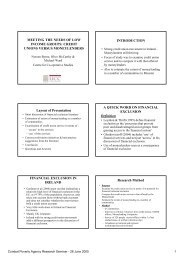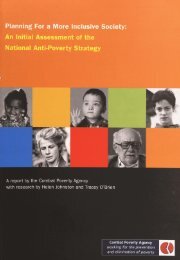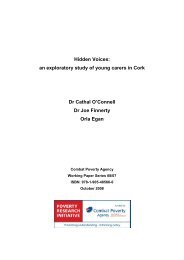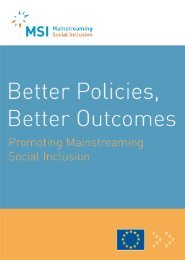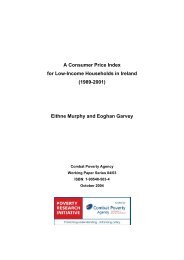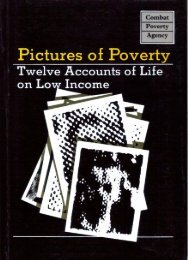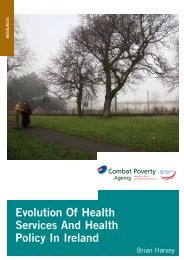The Distribution of Income in Ireland (2000) - Combat Poverty Agency
The Distribution of Income in Ireland (2000) - Combat Poverty Agency
The Distribution of Income in Ireland (2000) - Combat Poverty Agency
- No tags were found...
Create successful ePaper yourself
Turn your PDF publications into a flip-book with our unique Google optimized e-Paper software.
64<strong>The</strong> <strong>Distribution</strong> <strong>of</strong> <strong>Income</strong> <strong>in</strong> <strong>Ireland</strong><strong>in</strong>come from self-employment and capital, but earn<strong>in</strong>gs dom<strong>in</strong>atethat total. This was not, or not entirely, translated <strong>in</strong>tohigher <strong>in</strong>equality <strong>of</strong> disposable <strong>in</strong>comes because both transfersand taxes <strong>of</strong>f-set its effects, and <strong>in</strong>deed <strong>in</strong> most countries theredistributive impact <strong>of</strong> taxes and transfers <strong>in</strong>creased over theperiod.<strong>The</strong> decl<strong>in</strong><strong>in</strong>g share <strong>of</strong> earn<strong>in</strong>gs or market <strong>in</strong>come go<strong>in</strong>g tolower <strong>in</strong>come groups here refers to total household earn<strong>in</strong>gs,with households ranked by equivalised disposable <strong>in</strong>come. Itcould reflect both changes <strong>in</strong> the distribution <strong>of</strong> earn<strong>in</strong>gsamong earners, and <strong>in</strong> the distribution <strong>of</strong> earners across households.<strong>The</strong> OECD study does not look at the first <strong>of</strong> these <strong>in</strong> detail,be<strong>in</strong>g focused on households, but does have some <strong>in</strong>terest<strong>in</strong>g<strong>in</strong>sights on the second element. It shows that the proportion<strong>of</strong> households <strong>of</strong> work<strong>in</strong>g age with no earner <strong>in</strong>creased <strong>in</strong>most countries, and that such households had much lower levels<strong>of</strong> <strong>in</strong>come than those with one or two or more earners. <strong>The</strong>proportion with two or more earners also <strong>in</strong>creased <strong>in</strong> abouthalf the countries, so there was a quite widespread tendencytowards polarisation <strong>in</strong>to work-rich and work-poor households.However, decomposition showed that the more important contributorto <strong>in</strong>creas<strong>in</strong>g <strong>in</strong>equality <strong>in</strong> household <strong>in</strong>comes was <strong>in</strong>creas<strong>in</strong>g<strong>in</strong>equality with<strong>in</strong> fully-employed versus workless versus"mixed" households.Another important pattern common to many <strong>of</strong> the countriescovered <strong>in</strong> the study was an <strong>in</strong>crease <strong>in</strong> the average <strong>in</strong>comes <strong>of</strong>the elderly towards the overall average. <strong>The</strong> ma<strong>in</strong> ga<strong>in</strong>s herewere for those aged between 66 and 74 rather than those aged75 and over, so it was recent retirees who were do<strong>in</strong>g better.Also, <strong>in</strong>equality with<strong>in</strong> the retirement-age population decreased<strong>in</strong> a considerable number <strong>of</strong> countries, though publicold-age pensions tended to become less rather than moreequally-distributed among that group reflect<strong>in</strong>g the importance<strong>of</strong> earn<strong>in</strong>gs-related components <strong>in</strong> many countries. Nonpensiontransfers, on the other hand, tended to become moreequally distributed among the work<strong>in</strong>g-age population, generallyreflect<strong>in</strong>g the impact <strong>of</strong> family cash benefits.IOQ^16 °f^D StUdy C ° VerS *" P eriod onl y U P to the mid-1990s, and thus does not <strong>in</strong>clude the period after 1994 when, as<strong>Ireland</strong>'s <strong>Income</strong> <strong>Distribution</strong> <strong>in</strong> International Perspective 65we have seen, <strong>in</strong>equality appears to have risen quite markedly<strong>in</strong> <strong>Ireland</strong>. None the less, it provides an enormously valuablecomparative framework with<strong>in</strong> which the Irish experience canbe set, and helps to br<strong>in</strong>g out some <strong>of</strong> the factors which meritfurther <strong>in</strong>vestigation <strong>in</strong> the Irish case.5.5 CONCLUSIONSThis chapter has exam<strong>in</strong>ed <strong>in</strong> some detail the distribution <strong>of</strong>disposable <strong>in</strong>come <strong>in</strong> <strong>Ireland</strong> compared with other EU memberstates <strong>in</strong> the mid-1990s, us<strong>in</strong>g data from the EuropeanCommunity Household Panel survey. <strong>Ireland</strong> ranked as one <strong>of</strong>the more unequal <strong>in</strong> the European Union, along with the UKand Greece, though less so than Portugal. In the earlier studyby Atk<strong>in</strong>son, Ra<strong>in</strong>water and Smeed<strong>in</strong>g based on data from themid-late 1980s, <strong>Ireland</strong> ranked among the most unequal <strong>in</strong> theOECD. <strong>The</strong> more recent data suggest rather that <strong>Ireland</strong> is one<strong>of</strong> a group <strong>of</strong> EU countries with relatively high <strong>in</strong>equality,much higher than for example Denmark. This conclusion holdswhen one adjusts <strong>in</strong>come for differences <strong>in</strong> household size andcomposition us<strong>in</strong>g equivalence scales. <strong>The</strong> equivalence scaleemployed was seen to make a difference to the level <strong>of</strong> theG<strong>in</strong>i coefficient <strong>in</strong> some countries, but not the overall pattern<strong>in</strong> terms <strong>of</strong> country group<strong>in</strong>gs. In particular, from an Irish perspectiveit does not affect the plac<strong>in</strong>g <strong>of</strong> <strong>Ireland</strong> <strong>in</strong> a groupwith the UK, Greece and Spa<strong>in</strong>, hav<strong>in</strong>g the highest level <strong>of</strong><strong>in</strong>equality <strong>in</strong> the EU except for Portugal.As far as <strong>in</strong>ternational trends <strong>in</strong> <strong>in</strong>come <strong>in</strong>equality are concerned,a fairly widespread though not universal trend towards<strong>in</strong>creased <strong>in</strong>equality <strong>in</strong> the period from the mid-1980sto the mid-1990s is found <strong>in</strong> a recent OECD comparative study.<strong>The</strong> most notable common underly<strong>in</strong>g feature noted was thatthe share <strong>of</strong> earn<strong>in</strong>gs go<strong>in</strong>g to the lower <strong>in</strong>come groupsamong the work<strong>in</strong>g population decreased <strong>in</strong> all the countriescovered <strong>in</strong> the study. This was not, or not entirely, translatedmto higher <strong>in</strong>equality <strong>of</strong> disposable <strong>in</strong>comes because bothtransfers and taxes <strong>of</strong>f-set its effects, and <strong>in</strong>deed <strong>in</strong> manycountries the redistributive effects <strong>of</strong> taxes and transfers <strong>in</strong>creasedover the period. <strong>The</strong> Irish data <strong>in</strong>cluded <strong>in</strong> that study




